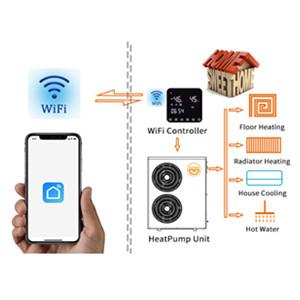Air Source Heat Pump Best Location
There are many things you need to consider when installing a heat pump for the first time. Knowing the best installation location is one of them. If the heat pump is in the recommended location, it will work efficiently, reduce your operating and service costs, last longer, and disturb people less.
This article will discuss how to choose the best location to install a heat pump, especially an outdoor unit, as its location can significantly affect performance. But we'll also discuss where to install the indoor unit to better distribute the air and keep all family members comfortable.
Open to outside air...
Obviously, air source heat pumps rely on outside air to function. Air temperatures can be as low as around -20 °C. However, they do require a good supply of free-flowing ambient air. That means they can't be on porches, facing walls, or in spaces that are usually tightly enclosed.
We're often asked why we can't put an air source heat pump inside, maybe in an attic or greenhouse? The answer is that after a few hours, the heat pump will extract all the heat from the trapped air, effectively turning the space into a freezer. This is why air source heat pumps require exposure to free-flowing outside air.
Access your air source heat pump…
The next thing to consider is accessibility. Air source heat pumps are notoriously sturdy machines that usually last a long time.

Air source heat pump
However, your system will require annual service to keep the system running smoothly and will require you to pay renewable heat incentives. This means you'll want engineers to have easy access to your air source heat pump if work needs to be done on it.
Placing the pump in an inconvenient location can prevent engineers from performing all the necessary checks the system requires. The ideal location is on the ground, where engineers have easy access to all sides of the air source heat pump and space to move and remove the outer panels freely.
Close...but not too close...
The third is being close to your home. It's best to place an air source heat pump on the floor outside your home's exterior walls. This is because less plumbing is required to connect the unit to the tank, so there is less opportunity for heat to escape during the transfer phase.
You also need to pay attention to the defrost cycle in winter. In sub-zero temperatures, air source heat pumps enter a "defrost cycle" to thaw ice or frost that has formed on external equipment, which can cause thawed water to freeze, so if you want to place equipment, be careful near any frequented path.
You'll also want to make sure your air source heat pump has free airflow at the back of the unit and isn't flush with the wall it's attached to. If it were through the heat transfer coil, the cool air would blow back into the equipment, causing it to lose efficiency.
Prevent noise...
Next, we must determine the best location for your pump to prevent noise irritation. Contrary to what some people think, air source heat pumps are actually pretty quiet. The Leomon sun 300 actually has a sound pressure level of 45dB at one meter, for reference, it's 1dB louder than a normal library, about 70dB quieter than a normal dishwasher and about 60dB quieter than a normal gas boiler. So in reality, it's like having a gas boiler...bolted to the outside of your house...that's not bad for the environment.
Still, it's best not to place an air source heat pump directly under a window in a commonly used room like a bedroom or living room, as in winter when the air source heat pump has to speed up, you may hear a faint humming sound due to the lower temperature rise .
The general "restricted zone"...
The last point is more common sense, don't put an air source heat pump in a location you think might be dangerous. Air source heat pumps are very resilient mechanical parts, but they work best when they are not exposed to flooding, leaking gutters, subsidence ground conditions, and other obvious locations that can hinder the smooth operation of a heating system.
Aside from these obvious places, there are plenty of places your air source heat pump can be placed on your property to ensure you have a fully efficient system where it won't be an inconvenience.
Final thoughts
At first glance, the requirements for setting the heat pump clearance distance may seem straightforward. However, things can quickly get complicated when you consider other relevant factors.
For these reasons, it is best to consult a professional when installing a heat pump at any distance from the house. It also doesn't hurt to hire an inspector to make sure your installation meets the code requirements. Better to be safe than sorry.





